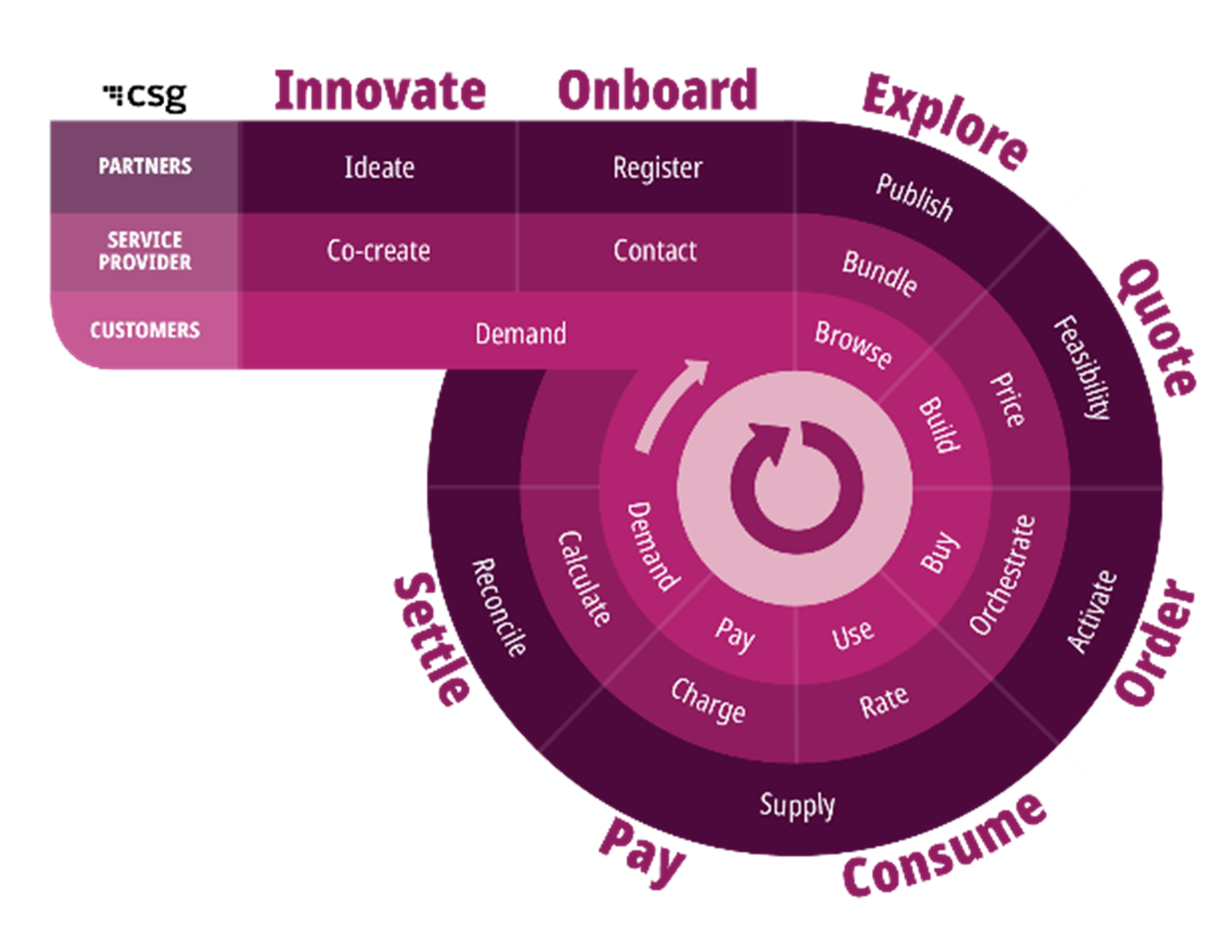Most communications service providers (CSPs) aren’t ready to capitalize on B2B2X services—not with their current BSS stacks. Over 50% of respondents in a recent TM Forum survey stated that their current BSS stacks would be able to handle less than 50% of the 5G and B2B2X services they plan to sell—in terms of charging, billing, digital commerce, etc. This highlights that CSPs are still struggling with existing issues of legacy and siloed systems, manual processes, and, ultimately, poor customer experiences.
A few large or forward-looking CSPs are on track to build fully functional digital marketplaces within the next two to three years. However, many CSPs will struggle to launch such platforms; reducing their ability to bundle third-party services and solutions with their connectivity offerings and impeding their quest for growth.
CSPs understand the endgame: cloud-native, programmable networks and intent-based automation. The ability to expose parts of the network and systems to partners and customers is arguably the key benefit of adopting a programmable open standards-based architecture. It enables all stakeholders in a digital ecosystem (including end-customers, software and hardware vendors, cloud service providers, etc.) to build, launch and monetize their offers, applications and services. It opens the door to previously unimagined services and applications. While many are still chasing the 5G killer use case, the market leaders are looking to transform their networks and BSS stacks into operational frameworks that can pivot to any use case as and when it arises.
The key question is where to start
More and more CSPs are expanding their portfolios to include third-party products and services to tap into the alluring promise of a lucrative B2B market. With enterprise customers now accustomed to frictionless, B2C-style, end-to-end experiences from online marketplaces (such as those run by AWS and Google Cloud), CSPs are feeling the pressure to deliver equally seamless and attractive experiences. However, for CSPs, the onboarding, delivery and maintenance of these bundled solutions and services is complex—sometimes overwhelmingly so.
CSPs must respond to customers’ expectations for consistent purchasing experiences to maintain their B2B and B2B2X base. Yet, CSPs struggle with siloed or poorly integrated systems, multiple product catalogs and legacy BSS stacks, creating poor customer experiences.
For many CSPs, adding third-party products and services to their portfolios is a long, expensive and error-prone process—that needs to be repeated for each and every partner and each and every product that a CSP wishes to ingest. In addition, most CSPs struggle with inconsistency in product rendering, pricing or configuration between channels. Ultimately, this all leads to confused and unhappy customers.
CSPs want to bring new value propositions to their customers quickly and cost-effectively. They need to enable partnerships by allowing their systems to easily plug into third-party systems with little to no integration cost. They need the process to be repeatable, scalable and flexible.
To fulfill all these needs, where do CSPs start?
Answer: With the right solution that makes it easier for CSPs to build out dynamic B2B2X marketplaces. This means making it easier for all parties to participate, including those with different industry standards and those who don’t have sophisticated, catalog-driven systems. The point is to remove as much friction as possible by supporting the essential marketplace integration effort with a zero-code solution, which minimizes implementation cost and effort for all participants. In addition, the solution must enable CSPs to quickly respond to revenue-generating opportunities, shorten their lead-to-cash cycles and deliver intuitive, omnichannel experiences to all customers and partners.
Related Whitepaper: Cloud-Native Billing Designed To Propel Your Business Innovations
The solution
CSG has defined an industry-first solution that allows CSPs to leverage catalog-driven integration to provide a frictionless user experience across all channels. CSG’s patented solution now means that a bundled offer can be built from CSP components and ingested partner components and then quoted, ordered and managed with zero-code integration.
CSG’s patented solution augments existing TM Forum industry standards to support multi-sided B2B2X business models with a strong omnichannel strategy, self-service agility, cross-selling, B2B personalization and a shorter lead-to-cash cycle.
The patent covers defining a product specification using an Industry Standard format. The product specification is then augmented with CSG’s proprietary rules language and presented to user-interfaces and APIs to consume with its associated relationships and rules. This enables the delivery of a completely metadata-driven quote-and-order user experience across many channels. Being metadata-driven, this allows the same APIs to be used for many different products and services, and it allows product and service specifications to be shared openly between different systems. This approach reduces redundant, repetitive spend on integration.

“Enterprises and their partners alike want to interact and transact digitally without having to make significant investments into the creation of components from multiple suppliers themselves. B2B2X ecosystems, which bring together digital services from several partners, are the foundation for delivering these seamless experiences. To be successful, they require an open, integrated solution that can manage the complex commerce cycles needed for CSPs to engage with a more diverse range of partners. This patent reinforces CSG’s emphasis on helping telco operators resolve the complexities of B2B2X marketplaces and capitalize on new monetization opportunities.”
John Abraham, Principal Analyst, Appledore Research.
Read our full press release here
According to a recent TM Forum report, 82% of respondents stated they will need to automate more systems and processes to reduce complexity. CSG helps CSPs address this need by enabling them to respond to market demands faster and begin to innovate and co-create with partners and customers.
Related eBook: Success Factors for CSPs’ Omnichannel Strategy
As CSPs continue transforming to digital business models for B2B and B2B2X, they recognize that complexity is unavoidable as they build rich, sophisticated, multi-party business models. Those providers who strategically manage that complexity will be the ones who thrive in the new digital economy. With a cross-industry ecosystem of partners, and a vast range of on-network and off-network offerings, CSPs can manage complexity by leveraging automation, intelligence and orchestration to make growth scalable.
And CSG Encompass enables just that. Contact our expert team today.

